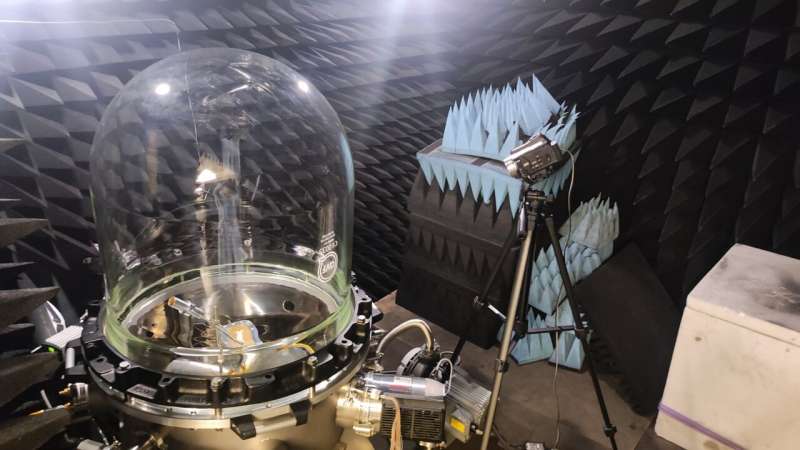This article has been reviewed according to Science X's editorial process and policies. Editors have highlighted the following attributes while ensuring the content's credibility:
fact-checked
trusted source
proofread
Discharge test for launcher antenna

Keeping a launcher in flight connected with the ground is one of the toughest jobs an antenna can have. Having to contend with high temperatures, vibration and atmospheric slipstream is hard enough, but shifting atmospheric pressure levels as the launcher heads into the vacuum of space (and potentially back again) can risk dangerous electrical discharges called corona—being tested for here.
The antenna design being tested at ESA's High Power Radio Frequency Laboratory in Valencia, Spain, is one of a quartet that is about to see service on Spain's Miura 1 sub-orbital micro-launcher, developed by the PLD Space company. But the four antennas are also undergoing a separate test campaign to qualify them for wider future uses.
"There are four different antenna types in all, each being flown in pairs aboard Miura 1," explains ESA antenna engineer Victoria Iza.
"One is a Global Navigation Satellite Signal antenna, using satellite navigation signals to track the launcher's position; one is an S-band antenna to transmit telemetry plus C-band and UHF antennas that both serve the security system that will end the flight safely in case of malfunction, operating on a redundant basis.
"Built by Spain's Anteral company, this quartet of conformal dielectric antennas—each roughly the size of a smartphone and made to fit around the hull of the upper stage—has already been qualified as part of the avionics bay of the Miura 1. But with the number of European small launchers increasing rapidly, supported by ESA's Boost! program, the potential is there for these antennas to find wider uses, so they are being put through a separate qualification program."
Taking place through ESA's General Support Technology Program, helping develop promising new products for space and the open market, the antennas are currently undergoing environmental testing including thermal vacuum where they are exposed to sustained vacuum and temperature extremes—and vibration tests.
These antennas have to sustain harsh thermomechanical environments during launch, orbital flight and eventual return to Earth, so the project has been supported on the ESA side by structures engineer Goncalo Rodrigues and thermal engineer Miguel Copano.
Key stress factors are vibrations propagating from the launch vehicle jet engines, shocks resulting from the fairing and stages separation and the extreme temperatures resulting from aerothermal fluxes and—once in orbit—alternating Sun and cold space exposure.
To check the antennas designs can not only survive but go on operating as intended, the team employed a combination of computer simulations and on-ground test facilities including electro-magnetic shakers, pyro-shock tables and thermal-vacuum chambers.
"Most of the testing has been carried out at the Public University of Navarra, UPNA, but ESA's High Power Radio Frequency Lab was used for corona discharge testing," adds Victoria.
"When a radio frequency antenna is surrounded by a vestigial amount of atmosphere—as when a launcher is either leaving or returning to a planetary atmosphere—then there is the potential for this air to become ionized by the radio signal, risking damaging lightning-like discharge.
"The antennas were placed in this glass container so that their surrounding air levels can be changed while the antennas are in operation; the glass does not impede the radio signals. Our full test campaign will conclude soon, hopefully helping the antennas to find fresh markets, not only for launchers—for instance, their demonstrated robustness means they could also be used aboard planetary landers."
"For Anteral, the development of these antennas is key to our positioning in the small launcher market," explains Fernando Teberio, Chief Technology Officer of Anteral.
Anteral CEO Itziar Maestrojuan notes, "Thanks to the support from ESA we have been able to fully qualify the antennas that will be used on Miura-1 and hopefully on many other launchers and different applications where reliability is a key parameter."
Provided by European Space Agency





















